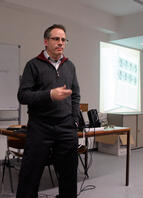American Corner Innsbruck
Lecture by Prof. Scott Curtis
Framing Babies: Arnold Gesell’s Infant Behavior Films
Monday, 15 November 2010, 6.15 p.m., room 4U102a (GeiWi building, basement)



The American Corner Innsbruck was proud to welcome Prof. Scott Curtis, Associate Professor of Radio/Television/Film at Northwestern University in Evanston, Illinois, who gave an inspiring talk about the work of the American psychologist Arnold Gesell, a pioneer in the field of child development.
From the 1920s through the 1940s, Arnold Gesell made and analyzed thousands of motion pictures of children at the Yale Clinic of Child Development to record children’s infant behavior patterns. Gesell’s multiple publications, for example his famous Atlas of Infant Behavior, have proven to be seminal works, still influencing our perception of child development today.
Using the latest technology in his research, Arnold Gesell became most popular for documenting developmental stages of children, ranging from infants to adolescents, by using motion picture technology. He was thus one of the first to use film for a multitude of scientific ends: as an illustration and aid to demonstration; as a device to generate many images for comparison and correlation; and as a source of quantitative data extracted by means of frame-by-frame analysis. Outstanding is Gesell’s notion of the motion picture as a tool comparable to anatomical dissection that allows for behavioral patterns, which are essentially ephemeral, to become like tissue and therefore attain a haptic quality. In his highly illuminating and thoroughly engaging talk, Prof. Scott Curtis presented some of Gesell’s most famous video clips that were to become the source of his many publications. Using the example of Arnold Gesell and his application of moving images, Prof. Scott Curtis demonstrated the fascinating interdependency between technology and the developmental study of children’s behavior patterns.
The talk was followed by a highly engaged discussion.
(text: Christof Diem and Martina Netzer)
Abstract
This lecture will consider the work of American psychologist Arnold Gesell (1880-1961), who, from the 1920s through the 1940s, used motion picture technology at the Yale Clinic of Child Development to record the behavior of hundreds of children, ranging from infants to adolescents. These research films formed the basis of Gesell’s theories of development and served as illustrations in his many publications. Indeed, much of what we feel we know about infant development comes from Gesell’s work—which in turn comes from his use of motion pictures. So this lecture will demonstrate the intricate and fascinating relationship between a technology, a method of analysis, and a theory of child development. In other words, it will show just how important motion pictures are to our understanding of the human infant.
Professor Scott Curtis
Scott Curtis is Associate Professor of Radio/Television/Film at Northwestern University in Evanston, Illinois, where he teaches film history and theory. His research focuses on early and silent-era cinema, but he is particularly interested in the institutional appropriation of motion pictures, such as educational filmmaking or the use of moving image technology as a scientific research tool or diagnostic instrument. He has published on a wide variety of topics, including early film theory; film sound; animation; Alfred Hitchcock; Douglas Fairbanks; the Motion Picture Patents Company; industrial film; and the scientific use of motion pictures, such as medical cinematography and microcinematography. He is also the President of Domitor, an international association dedicated to the study of early cinema.


